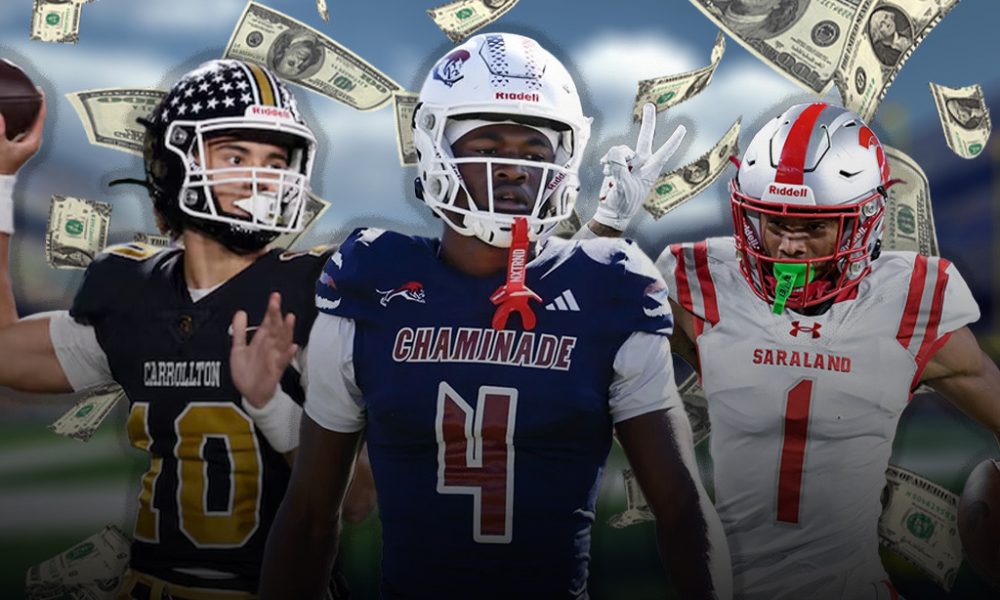NIL
NIL Collectives Paying High School Athletes To Stay Committed? It’s Beyond Wild
Ok, now the NIL business is getting crazier PublishedMay 30, 2025 12:18 PM EDT•UpdatedMay 30, 2025 12:18 PM EDT Facebook Twitter Email Copy Link If you’re wondering how crazy things have gotten in college athletics over the past few years when it comes to paying players with NIL deals, look no further than high school […]

Ok, now the NIL business is getting crazier
If you’re wondering how crazy things have gotten in college athletics over the past few years when it comes to paying players with NIL deals, look no further than high school athletes being compensated for staying committed to a particular school leading up to their actual signing.
While we wait to see how the House settlement will play out over the next few years, if approved, there has been a run on making sure high school or transfer portal athletes are taken care of financially before enrolling at whichever school they commit to.
Right now, there are a plethora of colleges making sure to get a good chunk of an athlete’s contract off the books before the July 1st start date for revenue-sharing. What we’ve seen over the past few months has been fascinating, to say the least. A number of high-profile transfer portal players are being paid up-front, which would not count towards the cap that will be put into place this summer.
But, there has been an interesting tactic used since the inception of NIL that has led to a number of players cashing checks so that they stay committed to one particular school. As we all know, a high school athlete putting out a social media post that declares their intentions of signing is pretty much useless in this current era of college athletics.
Just two weeks ago, Richard Wesley committed to Oregon by using a very awkward video that included Dan Lanning announcing his loyalty to the Ducks. Sixteen days after that video was released on social media, Wesley decided to de-committ from Oregon, which made that video look even worse for the folks who put it together.
But, is there a way for schools to make sure a prospect stays loyal to the program after committing? Sure, it comes with a financial agreement that some would categorize as shady business.
Georgia’s Kirby Smart mentioned to Yahoo Sports that some schools, through 3rd party collectives, are paying high school athletes upwards of $20,000 a month for their commitment.
“Teams that are unusually good at recruiting right now are doing it. Kids are getting money, but if you decommit, you owe that money back,” Smart told Yahoo. “These are high school kids getting money from an entity not affiliated with the university but is a collective of the university.”
That’s right, schools are paying athletes that much money to make sure they stay loyal to their program in the months leading up to their actual signing.
While Kirby Smart might’ve pointed out that athletes would have to pay that money back if they decided to go elsewhere, how a collective would actually recoup that money is the better question. What are they going to do when the athlete decides that he’s not going to pay them back? Are you going to sue them?
Would Collectives Sue High School Athletes Over The Lost Money?
That would go over well in a courtroom. The judge would look at the contract and most likely point out that this is technically pay-for-play, and tell the school that it’s their loss. If you are willing to pay a seventeen-to-eighteen-year-old kid that much money, knowing they could change their minds at any moment, you had better be willing to lose out on that financial investment.
Right now, we are seeing some programs come in at the last second and offer a young athlete twice as much at the last second to steal them away. So, if a player is committed for six months, and has already taken upwards of $70,000 to the bank off signing an NIL deal with a shady clause that paid them for their commitment, the collective has to understand the risk they took was not guaranteed.
It should also be noted that some high school athletes are demanding a ‘visit fee’, which can be upwards of $3,000 just to come to a school’s campus for a tour and meet with the coaching staff. But none of this part is new to college athletics, it’s just being discussed more now.
A lot of these financial agreements that we are seeing right now in college athletics are getting out of hand, but the high school athlete is not going to care about screwing over one school if he’s getting double the amount at another.
While most of these types of deals will be under intense scrutiny when the House settlement enforcement starts with the NIL clearinghouse, it doesn’t mean some of these college programs aren’t willing to take a risk right now in hopes of it paying off down the road.
Remember that any NIL deal over $600 will have to be cleared moving forward. But, it will be interesting to watch how many of these deals are flagged when folks start taking a closer look.
Welcome to the new era of college athletics.
Let me know what you think. Email me at Trey.Wallace@OutKick.com